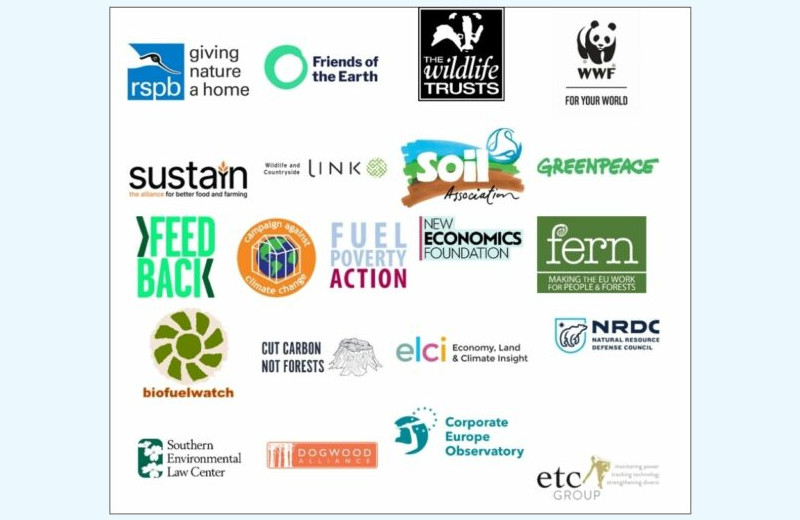Statement – 15 June 2021
Scientists urge governments to act aggressively over the next decade to keep global warming to 1.5°C and avert the worst consequences of climate change.[i] Pivotal to that effort are policies to quickly end reliance on dirty energy; support a rapid transition to genuinely non-emitting and renewable energy; and protect forests and other intact ecosystems as critical carbon sinks. Industrial scale biomass-burning in the power sector threatens all three pillars of climate action and should not be subsidised.
Industrial scale biomass-burning for electricity:
- Exacerbates climate change over key timeframes for climate action and risks undermining the UK’s net-zero emissions target and its desire to be a climate leader on the global stage.
- Degrades forests and threatens wildlife at the very moment when protecting nature is paramount.
- Emits dangerous air pollution linked to an array of health harms.
- Diverts public funds to a false climate solution instead of wind and solar projects built in harmony with nature, which guarantee real CO2 reductions – and more UK jobs — at a fraction of the cost.
Herein, as part of the BEIS call for evidence on the role of biomass in achieving net zero, the undersigned groups provide evidence regarding the UK’s supply of biomass; biomass end uses; challenges in ensuring biomass sustainability; and bioenergy with carbon capture and storage (BECCS). The evidence makes clear that biomass-burning in power stations at the scale currently relied upon by the UK cannot be sustainable. The best outcome for biodiversity and the climate would be to rapidly phase out UK reliance on large-scale biomass electricity.
UK Biomass Supply and its Impact
Burning wood harvested from forests to generate electricity contributes to climate change.[ii] 500 scientists recently wrote to world leaders that, “As numerous studies have shown…burning of wood will increase warming for decades to centuries. That is true even when the wood replaces coal, oil or natural gas.”[iii] The European Academies Science Advisory Council likewise cautions that using forest biomass for power “is not effective in mitigating climate change and may even increase the risk of dangerous climate change.”[iv] Yet, the UK imports and burns more wood for electricity than it produces from its own plantations.[v]
Bioenergy is treated as zero-emitting in the UK energy sector and elsewhere only because UNFCCC accounting rules assume carbon emissions associated with biomass removals will be properly accounted for in the land use sector of the country where it is sourced. However, many countries do not account fully, or at all, for their land use emissions.[vi] As a result, large quantities of emissions associated with bioenergy are simply “missing” from international ledgers. This accounting loophole creates a significant policy incentive to subsidise biomass-burning for power or BECCS as a low-carbon energy source even when it is not.
Additionally, both Drax and UK carbon accounting rules ignore foregone sequestration in the forest resulting from biomass harvest for energy production — a major category of biomass emissions. Increased scientific understanding of forest carbon cycles suggests that were foregone sequestration to be included, forest bioenergy, even with CCS, will often be a carbon source rather than a carbon sink and lead to more emissions than other renewable energy technologies.[vii]
Roughly 80% of the pellets burned at Drax come from North America, with over two-thirds from the U.S. Southeast. The remainder comes from Europe, principally the Baltics and Russia. Nearly 40% of the U.S. wood burned at Drax is large-diameter whole trees (what Drax calls “low-grade roundwood”).[viii] These trees are routinely sourced from clearcuts of mature hardwood forests.[ix] Scientists have concluded this biomass is high-carbon and should not be included in bioenergy schemes.[x] Another quarter of Drax’s wood fuel is sourced from the thinning of smaller trees in softwood pine plantations. Peer reviewed research shows that burning this biomass likewise increases heat-trapping carbon pollution in the atmosphere for over forty years – well outside Paris Climate Agreement timeframes for climate action.[xi]
There has been much talk about scaling up domestic sources of biomass, however in the Climate Change Committee (CCC)’s Sixth Carbon Budget Balanced Net Zero Pathway, the volume of biomass imports increases to 2050.[xii] Less than 1% of the biomass burned at Drax today is sourced from within the UK.[xiii]
Further, contrary to a transition away from imported biomass, Drax is locking in its import supply chains. The company recently purchased Pinnacle Renewable Energy in Canada, the second largest producer of industrial wood pellets in the world, and now has ownership interests in a total of 17 other pellet plants and development projects across the U.S. and Canada.[xiv] This makes Drax not only the largest wood-burning power station in the world, but a top pellet manufacturer, with interests in expanding global markets for burning pellets.
Under the CCC’s Balanced Net Zero pathway, meeting biomass demand for BECCS would require converting up to 700,000 hectares of UK land (3% of the UK’s total land area, or more than four times the size of Greater London) to grow energy crops, in addition to imports.[xv] Reducing the land available for food production in the UK risks greater intensification of agriculture, a reduction in food security, or the conversion of valuable habitats to food production. Factoring in the carbon costs of pesticide use, fertiliser use, harvest and transportation, any climate benefit that is realised may be lower than if the same land was used for another carbon-absorbing activity, such as native tree-planting.[xvi]
Further, the UK is one of the most nature depleted[xvii] and least wooded[xviii] countries in Europe. Giving over more land to plantations simply to burn for energy would move the country in the wrong direction.
Finally, setting an international precedent for reliance on BECCS to meet net zero targets poses a massive risk. Globally, the IPCC’s medium scale BECCS deployment of 12Gt CO2e per year could require up to 0.8 billion hectares of land.[xix]
End Uses of Biomass
Unlike solar and wind, large-scale wood-burning in power stations also emits dangerous air pollution that causes an array of health harms, from asthma attacks to cancer to heart attacks, resulting in hospital visits and premature deaths.[xx] In its 2019 Clean Air Strategy, the Government said it would consult on closing subsidies to new biomass conversions to help reduce deadly emissions of PM 2.5.[xxi] Yet, it exempts existing biomass plants, a significant source of today’s emissions.[xxii]
Evidence from the U.S. suggests that as coal is replaced by biomass to generate electricity, it is also replaced by biomass as a major source of air pollution that impacts public health. Peer reviewed science published in May 2021 states that, “The increasing role of gas and biomass and wood emissions in the health burden of PM2.5 exposure indicates that swapping one air pollution-emitting fuel source for another is not a pathway to a healthy energy system.”[xxiii]
Wood pellet mills also release unsafe air pollution, at times at levels that violate plant permits and U.S. law, which has led to legal challenges against Drax’s pellet supplier Enviva. Drax has been cited for serious air quality violations at all three of its U.S. pellet mills. Drax was recently fined $2.5 million over serious air quality breaches at its pellet mill in Mississippi,[xxiv] the largest known fine ever levied on such a facility.[xxv]
UK Biomass Sustainability
Burning wood for large-scale electricity generation worsens climate change immediately, and the harm it causes can persist for decades or even centuries.[xxvi] It also endangers the very ecosystems we rely on to help stabilise global temperatures and make communities more resilient to climate change.[xxvii] The Government assures Parliamentarians and the public that so long as trees are sourced “sustainably” they can ignore these impacts. Yet, sustainability criteria do not prevent high-carbon and environmentally damaging biomass from routinely entering the UK energy market.[xxviii] Harmful practices, such as sourcing whole trees[xxix] and harvesting in sensitive forest ecosystems,[xxx] are all legal, common in countries supplying the UK’s biomass, and permitted under current governmental and corporate sustainability standards.
UK legal criteria for biomass only account for the fossil fuel related carbon emissions from processing and transporting wood pellets; they do not take into account the carbon emitted when the biomass is combusted or the carbon lost on the landscape from harvesting. Further, UK sustainability criteria do not prohibit sourcing biomass from highly biodiverse forests or through clearcutting practices. In fact, that is what is happening in the U.S. Southeast, Canada and the Baltics to supply biomass to the UK – all sourcing occurring under the UK’s sustainability criteria. Finally, while UK criteria may require that biomass be harvested legally (per the laws of the source country), such a designation does little if anything to protect biodiversity or ensure that biomass harvest and burning does not exacerbate climate change.[xxxi]
Voluntary corporate schemes are typically overseen by industry and likewise deeply flawed. The Sustainable Biomass Program (SBP), used by Enviva and Drax to certify biomass, is dominated by industry and built using a self-policing approach that has resulted in increased carbon emissions, accelerated loss of natural forests, and harm to local communities.[xxxii] Contrary to industry claims, repeated investigations by NGOs and the media show that whole trees are routinely taken from clearcut biodiverse forests to pellet mills that supply Drax.[xxxiii] Biomass industry jargon like “low-grade” and “residue” are poorly defined and speak to the economic value of the wood rather than its value in terms of biodiversity, climate resilience or culture.[xxxiv]
Beyond the SBP, sustainable forestry certification programmes either do not include carbon accounting mechanisms or ignore crucial aspects of forest carbon accounting, and thus must not be used as a proxy for the carbon impacts of burning forest biomass. Likewise, “sustainable forestry” or “environmentally sustainable” practices, while plausibly beneficial for timber management or ecosystem/wildlife protection, cannot be treated as providing evidence that biomass harvested for energy production is carbon-beneficial.[xxxv] In a letter to European policymakers, 800 scientists underscore that, “Even if forests are allowed to regrow, using wood deliberately harvested for burning will increase carbon in the atmosphere and warming for decades to centuries – as many studies have shown – even when wood replaces coal, oil or natural gas. The reasons are fundamental and occur regardless of whether forest management is ‘sustainable’.”[xxxvi]
Bioenergy with Carbon Capture and Storage (BECCS)
BECCS is an expensive and speculative technology. As biomass is not carbon neutral,[xxxvii] policymakers cannot assume BECCS is carbon negative. Researchers at Chatham House have warned against overreliance on BECCS, stating that policymakers are in danger of sleepwalking into ineffective carbon dioxide removal solutions in the quest to tackle climate change.[xxxviii]
New analysis finds that in the case of wood pellets from plantations in the U.S. South — a top source of biomass for Drax – bioenergy even with CCS will be a significant carbon source rather than a carbon sink for many decades. This is because offsite emissions from wood pellet processing, drying, and transport can never be captured. Moreover, the analysis finds that even accounting for forest regrowth after cutting, BECCS cannot eliminate the post-harvest loss of carbon accumulation on the landscape for 30 years and, therefore, cannot deliver negative emissions by mid-century. Even if 100% carbon capture were possible at the stack, these ‘uncapturable’ emissions constitute over one-third of the total lifecycle emissions for sourcing and burning these pellets. This is equal to more than half the stack emissions at the plant. These results demonstrate that BECCS cannot fully mitigate emissions from burning pellets for electricity, and, more importantly cannot yield negative emissions.[xxxix]
Further, scientists warn that the deployment of BECCS at the scales assumed in most models would consume vast areas of land, comparable to half of global cropland today, entailing massive land-use change risks, and threatening food security and habitat.[xl] Recent estimates suggest a proposed BECCS plant at Drax Power Station will require £31.7 billion in subsidy.[xli]
Taken together, it is clear that any such programme to subsidise BECCS at Drax will be ineffective in drawing down emissions, risk significant harm to nature, and divert public resources better invested elsewhere. Instead, public money should be spent on protecting and restoring biodiverse ecosystems and carbon sinks in the UK and overseas; energy saving measures such as retrofitting homes; and genuinely clean and low-carbon energy, such as wind and solar power.
Evidence submitted by:
- RSPB UK
- The Wildlife Trusts
- WWF UK
- Friends of the Earth (England, Wales and Northern Ireland)
- Friends of the Earth (Scotland)
- Greenpeace
- Wildlife and Countryside Link
- Soil Association
- Sustain
- Feedback Global
- Fern
- Biofuelwatch
- Cut Carbon Not Forests
- NRDC
- Southern Environmental Law Center
- Dogwood Alliance
- Campaign Against Climate Change
- Economy, Land and Climate Insight
- New Economics Foundation
- Fuel Poverty Action
- Corporate Europe Observatory
- Etc Group
[i] Intergovernmental Panel on Climate Change, “Global Warming of 1.5 °C; Summary for Policymakers,” October 2018, https://report.ipcc.ch/sr15/pdf/sr15_spm_final.pdf.
[ii] M. T. Ter-Mikaeilian, S. J. Colombo, and J. Chen, “The Burning Question: Does Forest Bioenergy Reduce Carbon Emissions? A Review of Common Misconceptions About Forest Carbon Accounting,” Journal of Forestry 11, no. 1 (January 2015): 57-68, https://www.researchgate.net/publication/
Sami Yassa, “Think Wood Pellets Are Green? Think Again,” NRDC, May 2015, https://www.nrdc.org/sites/default/files/bioenergy-modelling-IB.pdf. Mary S. Booth, “Not Carbon Neutral: Assessing the Net Emissions Impact of Residues Burned for Bioenergy,” Environmental Research Letters 13, no. 3 (February 21, 2018), https://iopscience.iop.org/article/10.1088/1748-9326/aaac88. Spatial Informatics Group, The Carbon Impacts of UK Electricity Produced by Burning Wood Pellets from Drax’s Three U.S. Mills, May 27, 2019, https://www.southernenvironment.org/uploads/publications/2019-05-27_Drax_emissions_-_SIG_report_Phase_II.PDF.
[iii] Scientist Letter Regarding Use of Forests for Bioenergy, February 11, 2021, available: https://www.dropbox.com/s/hdmmcnd0d1d2lq5/Scientist%20Letter%20to%20Biden%2C%20von%20der%20Leyen%2C%20Michel%2C%20Suga%20%26%20Moon%20%20Re.%20Forest%20Biomass%20%28February%2011%2C%202021%29.pdf?dl=0
[iv] European Academies Science Advisory Council, “Climate Impact of Woody Biomass,” January 27, 2021, https://easac.eu/media-room/press-releases/details/easac-welcomes-that-the-jrc-report-strengthens-the-case-for-shorter-payback-periods-on-woody-biomass/
[v] European Academies Science Advisory Council, “Climate Impact of Woody Biomass,” January 27, 2021, https://easac.eu/media-room/press-releases/details/easac-welcomes-that-the-jrc-report-strengthens-the-case-for-shorter-payback-periods-on-woody-biomass/
[vi] Duncan Brack, “The Impacts of the Demand for Woody Biomass for Power and Heat on Climate and Forests, Chathm House, February 23, 2017, https://www.chathamhouse.org/sites/default/files/publications/research/2017-02-23-impacts-demand-woody-biomass-climate-forests-brack-final.pdf
[vii] Michael Norton et al., “Serious Mismatches Continue Between Science and Policy in Forest Bioenergy,” Global Change Biology Bioenergy 11, no. 11 (November 2019): 1256-1263, https://doi.org/10.1111/gcbb.12643; EASAC, “Forest bioenergy, carbon capture and storage, and carbon dioxide removal: an update, February 2019, https://easac.eu/fileadmin/PDF_s/reports_statements/Negative_Carbon/EASAC_Commentary_Forest_Bioenergy_Feb_2019_FINAL.pdf; Sami Yassa, forthcoming NRDC Fact Sheet to be published based on Memorandum from Hammerschlag LLC to Natural Resources Defense Council, June 6, 2021, available at: https://www.nrdc.org/resources/uncaptured-biogenic-emissions-beccs
[viii] Drax Group plc Annual report and accounts 2020, see table titled, Drax Power Station biomass pellet feedstock sources in 2020, pg 54. https://www.drax.com/wp-content/uploads/2021/03/Drax_AR2020.pdf
[ix] Global Markets for Biomass Energy are Devastating U.S. Forests, NRDC, Dogwood Alliance, Southern Environmental Law Center, June 17, 2019, https://www.nrdc.org/sites/default/files/global-markets-biomass-energy-06172019.pdf
[x] European Academies Science Advisory Council, “EASAC’s Environmental Experts call for international action to restrict climate-damaging forest bioenergy schemes,” September 10, 2019, https://easac.eu/media-room/press-releases/details/easac-s-environmental-experts-call-for-international-action-to-restrict-climate-damaging-forest-bioenergy-schemes/
[xi] European Academies Science Advisory Council, “EASAC’s Environmental Experts call for international action to restrict climate-damaging forest bioenergy schemes,” September 10, 2019, https://easac.eu/media-room/press-releases/details/easac-s-environmental-experts-call-for-international-action-to-restrict-climate-damaging-forest-bioenergy-schemes/
[xii] Climate Change Committee, “Sixth Carbon Budget,” December 9, 2020, https://www.theccc.org.uk/publication/sixth-carbon-budget/, pg 74.
[xiii] Drax Group plc Annual report and accounts 2020, see table titled, Drax Power Station biomass pellet feedstock sources in 2020, pg 54. https://www.drax.com/wp-content/uploads/2021/03/Drax_AR2020.pdf
[xiv] “Drax Completes Acquisition of Pinnacle Renewable Energy Inc,” GlobeNewswire, April 13, 2021, https://www.globenewswire.com/news-release/2021/04/13/2209296/0/en/Drax-Completes-Acquisition-of-Pinnacle-Renewable-Energy-Inc.html; “Drax begins construction of the first of three new pellet plants in Arkansas,” Lesprom, May 7, 2021, https://www.lesprom.com/en/news/Drax_begins_construction_the_first_of_three_new_pellet_plants_in_Arkansas_98713/
[xv] Climate Change Committee, “Sixth Carbon Budget,” December 9, 2020, https://www.theccc.org.uk/publication/sixth-carbon-budget/
[xvi] Tomos Harrison, “Gambling with Biomass: Reliance on BECCS undermines National Grid’s net-zero scenarios,” Ember, October 28, 2020, https://ember-climate.org/commentary/2020/10/28/gambling-with-biomass/
[xvii] “Biodiversity Loss; The UK’s global rank for levels of biodiversity loss,” RSPB, https://www.rspb.org.uk/globalassets/downloads/about-us/48398rspb-biodivesity-intactness-index-summary-report-v4.pdf
[xviii] Forest Research, “Forest cover: international comparisons,” 2021, https://www.forestresearch.gov.uk/tools-and-resources/statistics/forestry-statistics/forestry-statistics-2018/international-forestry/forest-cover-international-comparisons/
[xix] Mathilde Fajardy, Dr. Alexandre Koberle, Dr. Niall MacDowell, Dr. Andrea Fantuzzi, “BECCS deployment: a reality check,” Imperial College London, Grantham Institute Briefing paper No 28, January 2019, https://www.imperial.ac.uk/media/imperial-college/grantham-institute/public/publications/briefing-papers/BECCS-deployment—a-reality-check.pdf
[xx] Letter from prominent health organizations to U.S. Congress about the health harms of biomass, September 13, 2016. Available at: https://www.naccho.org/uploads/downloadable-resources/Policy-and-Advocacy/Health-organizational-letter-health-impacts-of-biomass.pdf
[xxi] Defra, “Clean Air Strategy 2019,” January 14, 2019, https://assets.publishing.service.gov.uk/government/uploads/system/uploads/attachment_data/file/770715/clean-airstrategy-2019.pdf
[xxii] EU Biomass Legal Case, “Drax (UK): 1,000 tonnes of deadly particulate pollution a year, a 400% increase since they switched from coal to biomass,” available at: Drax (UK): 1,000 tonnes of deadly particulate pollution a year, a 400% increase since they switched from coal to biomass – EU Biomass Legal Case (eubiomasscase.org)
[xxiii] Jonathan J Buonocore et al 2021 Environ. Res. Lett. 16 054030, https://www.eenews.net/assets/2021/05/05/document_gw_01.pdf
[xxiv] “UK-owned pellet plant in US fined $2.5m over air quality breaches, February 19, 2021, UK-owned pellet plant in US fined $2.5m over air quality breaches – BBC News
[xxv] Sara Sneath, “Mississippi biomass facility fined for emitting three times more air pollution than permitted,” Southerly, February 25, 2021, https://southerlymag.org/2021/02/25/mississippi-biomass-facility-fined-for-emitting-three-times-more-air-pollution-than-permitted/
[xxvi] Michael Norton et al., “Serious Mismatches Continue Between Science and Policy in Forest Bioenergy,” Global Change Biology Bioenergy 11, no. 11 (November 2019): 1256-1263, https://doi.org/10.1111/gcbb.12643.
[xxvii] “UK Biomass Imports Threaten Global Biodiversity,” Cut Carbon Not Forests, March 2021, https://www.cutcarbonnotforests.org/wp-content/uploads/2021/03/uk-biomass-threatens-global-biodiversity-fs.pdf
[xxviii] Biofuelwatch & Global Forest Coalition, Can Sustainability and Greenhouse Gas Standards Protect the Climate, Forests and Communities from the Harmful Impacts of Wood-Based Bioenergy? (2020), https://www.biofuelwatch.org.uk/wpcontent/uploads/Biomass-Sustainability-Standards-Briefing.pdf.
[xxix] Duncan Brack, “The Impacts of the Demand for Woody Biomass for Power and Heat on Climate and Forests, Chathm House, February 23, 2017, https://www.chathamhouse.org/sites/default/files/publications/research/2017-02-23-impacts-demand-woody-biomass-climate-forests-brack-final.pdf
[xxx] “UK Biomass Imports Threaten Global Biodiversity,” Cut Carbon Not Forests, March 2021, https://www.cutcarbonnotforests.org/wp-content/uploads/2021/03/uk-biomass-threatens-global-biodiversity-fs.pdf
[xxxi] Biofuelwatch & Global Forest Coalition, Can Sustainability and Greenhouse Gas Standards Protect the Climate, Forests and Communities from the Harmful Impacts of Wood-Based Bioenergy? (2020), https://www.biofuelwatch.org.uk/wpcontent/uploads/Biomass-Sustainability-Standards-Briefing.pdf.
[xxxii] “The Sustainable Biomass Program: Smokescreen for Forest Destruction and Corporate Non-Accountability,” NRDC, Dogwood Alliance, June 2017, https://www.nrdc.org/sites/default/files/sustainable-biomass-program-partnership-project-ip.pdf
[xxxiii] “Global Markets for Biomass Energy are Devastating U.S. Forests, NRDC, Dogwood Alliance, Southern Environmental Law Center, June 17, 2019, https://www.nrdc.org/sites/default/files/global-markets-biomass-energy-06172019.pdf
[xxxiv] Sasha Stashwick, “How the Biomass Industry Sent ‘Sustainability’ Up in Smoke,” NRDC Expert Blog, July 25, 2019, https://www.nrdc.org/experts/sasha-stashwick/how-biomass-industry-sent-sustainability-smoke
[xxxv] Ibid.
[xxxvi] Letter from Scientists to the EU Parliament Regarding Forest Biomass, January 14, 2018, available at: http://www.pfpi.net/wp-content/uploads/2018/04/UPDATE-800-signatures_Scientist-Letter-on-EU-Forest-Biomass.pdf
[xxxvii] Timothy D. Searchinger, et al., “Fixing a Critical Climate Accounting Error,” Science Vol 326, October 23, 2009, https://www.pfpi.net/wp-content/uploads/2011/03/Searchinger-et-al-2009.pdf
[xxxviii] Duncan Brack, Richard King, “Net Zero and Beyond: What Role for Bioenergy with Carbon Capture and Storage?,” Chatham House, January 29, 2020, https://www.chathamhouse.org/2020/01/net-zero-and-beyond-what-role-bioenergy-carbon-capture-and-storage
[xxxix] Sami Yassa, forthcoming NRDC Fact Sheet to be published based on Memorandum from Hammerschlag LLC to Natural Resources Defense Council, June 6, 2021, available at: https://www.nrdc.org/resources/uncaptured-biogenic-emissions-beccs
[xl] Mathilde Fajardy, Dr. Alexandre Koberle, Dr. Niall MacDowell, Dr. Andrea Fantuzzi, “BECCS deployment: a reality check,” Imperial College London, Grantham Institute Briefing paper No 28, January 2019, https://www.imperial.ac.uk/media/imperial-college/grantham-institute/public/publications/briefing-papers/BECCS-deployment—a-reality-check.pdf
[xli] Phil MacDonald, Tomos Harrison, “Understanding the cost of the Drax BECCS plant to UK consumers,” Ember, May 25, 2021, https://ember-climate.org/project/cost-drax-beccs-plant/




